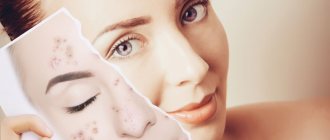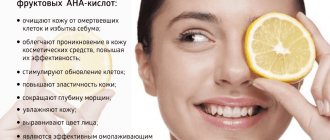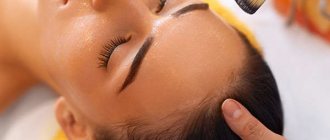What is glycolic acid?
Glycolic acid is a type of water-soluble alpha-hydroxyl fruit acids, obtained both synthetically and from natural plant components - sugar cane, bamboo, grapes. Both types of production are used in cosmetology - there is no significant difference between them.
Among all AHA acids, glycolic has the lowest molecular weight and acidity, which increases its ability to penetrate the epidermal layers of the skin and react instantly. The activity of the action and the depth of penetration depend on the pH level - the lower it is (more acidic), the higher the effectiveness of the acid.
Help with acne
In order for the treatment to be more effective, it is necessary to choose the right product for use. Not all glycolic products are suitable for acne-prone skin. The choice should be made based on the following factors:
- What is the fat percentage? If it says it contains “0% fat,” it means it’s not there. Such products do not contain fats, but contain nutritional and moisturizing components.
- The pH level coefficient should not exceed 4. The effectiveness of the acid increases with decreasing pH level. The lower this value, the more the skin is protected from damage.
Acne treatment
The process of getting rid of this type is completed in four steps:
- First: regular, daily cleansing of the face. When washing, try not to allow the skin to dry out, as peeling may occur, and, accordingly, new acne formations. There is no need to use alkaline products when washing your face, this will neutralize the skin's sebum.
- Second: cleansing pores that are clogged. If the contamination is superficial, home cleaning methods are suitable. If the blockage is deep, the situation becomes more complicated. You will have to resort to salon procedures.
- Third: treatment of inflammation. To do this, you will need to contact a dermatologist, since this is a very important process that requires an individual approach.
- Fourth: preventive measures. After achieving positive results, you should not breathe a sigh of relief and think that the problem is solved forever. Because relapses may occur. Prevention is also very important. Combining salon skin cleansing procedures and home skin care methods will give results for the longest possible period.
Glycolic acid should be added to cosmetic peeling lotions, as well as to creams used during treatment. Typically, its concentration in these cases should not exceed 5-10%. The peculiarity of using such lotions is that they are applied to the face in the same way as other cosmetics, but they are washed off without allowing them to be completely absorbed.
Although glycolic acid is great for acne, you need to know that this does not happen overnight. To completely cleanse the skin of all unnecessary elements, you will need to make a lot of effort and spend time. The correctness of the procedures will undoubtedly lead to a positive effect.
How is glycolic acid used?
In cosmetics
Due to its powerful keratolytic properties, glycolic acid is used in cosmetics for enhanced exfoliation of dead skin cells, skin renewal, deep cleansing and rejuvenation. Most often, the substance is found in the basis of active formulas for oily and problem skin types, as well as for mature skin. When choosing an acid-containing product for care, pay attention to the concentration.
Beauty formulas based on glycolic acid also activate the synthesis of natural collagen, elastin and hyaluronic acid, increasing skin turgor. Since alpha hydroxyl acid is water-soluble, it is not recommended to combine products based on it with dense fatty and oily formulas - this will reduce its effectiveness.
In cosmetology
One of the most popular salon facial skin treatments is glycolic facial peeling. The procedure is a type of chemical peeling with fruit acids: it effectively evens out the color and texture of the skin, and accelerates the regeneration of epidermal cells.
The high concentration of acid in the peeling composition (from 30%) has a powerful renewing and rejuvenating effect. Such facial cleansing is a traumatic renewal procedure and requires subsequent restorative, moisturizing and softening care. Be sure to protect your skin from UV rays and use sunscreen even in the cold season, for example, Anthelios Sunscreen Invisible Fluid SPF 50+/PPD 46.
Where to sign up for glycolic facial peeling in Moscow
Nowadays, you no longer have to spend a lot of time performing complex and unpleasant procedures at home. It is much easier to seek help from real professionals - the Veronika Herba beauty and health center, equipped with effective and modern equipment.
Why clients choose Veronika Herba Beauty and Health Center:
- This is a beauty center where you can take care of yourself at a reasonable cost, while your face and/or body will be treated not by an ordinary cosmetologist, but by one of the best dermatologists in Moscow. This is a completely different, higher level of service!
- You can receive qualified help at any time convenient for you. The beauty center is open from 9:00 to 21:00, seven days a week. The main thing is to agree with your doctor in advance on the date and time of your appointment.
Sign up for a consultation with a specialist by phone +7 (495) 085-15-13
, and you will see for yourself!
Action and benefits of glycolic acid for facial skin
The rich range of actions it has on the skin makes glycolic acid one of the most popular components. Responsible for exfoliation, as well as due to its ability to rejuvenate, smooth, and prevent hyperpigmentation, alpha hydroxy acid satisfies the basic needs of oily skin and is widely used in anti-age beauty routines. Let's take a closer look at the beneficial properties of glycolic acid for the face.
- Evens out the color and texture of the epidermis.
- Fights age-related changes, smoothes even deep wrinkles.
- Compacts the deep layer of the epidermis, thins the superficial (horny) layer.
- Accelerates cellular renewal mechanisms.
- Increases tone, firmness and elasticity of the skin.
- Returns radiance and fresh appearance to facial skin.
- Helps get rid of signs of acne, has an anti-inflammatory effect: minimizes the appearance of acne, promotes the resorption of comedones, cleanses and tightens pores, reduces the visibility of blackheads.
- Helps get rid of post-acne: smoothes out stagnant spots, atrophic scars.
- Suppresses melanin production, corrects signs of photoaging: lightens hyperpigmentation, eliminates dehydration wrinkles.
Based on the above beneficial properties, we will highlight the most common skin problems and imperfections that glycolic acid is designed to combat.
Indications for the use of cosmetics with glycolic acid
- Early signs of aging.
- Visible age-related changes.
- Manifestation of photoaging.
- Hyperkeratosis.
- Acne (pimples, blackheads, comedones).
- Hyperpigmentation, malasma.
- Uneven relief and skin color, peeling.
- Post-acne marks.
Contraindications
- Individual intolerance to peeling ingredients
- Violation of the integrity of the skin
- Active inflammatory process on the skin
- Herpes in active phase
- Pregnancy and lactation
Preparations for pre-peeling preparation and post-peeling period for home use
- Cleanser Mousse and Gentle Cleanser Mousse
- Prepeel Light cream (or Prepeel Medium, Prepeel Active)
- Vegefarma Revitalizing Cream
- Post-peel cream Postpeel Light (or Postpeel Medium, Postpeel Active)
- Sunscreen Mediscreen spf 85
Features of using cosmetics with glycolic acid for different skin types
- For oily problem and combination skin Oily and problem skin types respond well to any products with glycolic acid on a daily basis. Anti-inflammatory and sebum-regulating products containing the component at the base of the formula have a keratolytic and renewing effect without dehydrating the epidermis. Also look for glycerin, hyaluronic acid, niacinamide, salicylic acid, or lipo-hydroxy acid in products for maximum results. The complex of salicylic and lipo-hydroxy acids can be used without the addition of LHA acids, as, for example, in the formula of Effaclar mattifying lotion.
- For dry and sensitive skin To achieve a light exfoliation effect without skin irritation, use a glycolic acid skin cream with a concentration of up to 5%. For sensitive skin, choose tonics or lotions with low content (up to 3%) 3-4 times a week. Formulas with a combination of acid, niacinamide, squalane, thermal water, and hyaluronic acid are also suitable to prevent skin irritation. If irritation or allergies occur, switch to a product with a lower content of the substance or stop using it altogether.
- For normal and mature To care for mature skin with visible signs of aging, you can use a complex of acids in the formula, such as BHA and AHA acids. Professional peelings with a high content of alpha hydroxy acid will help to intensively renew the epidermis. Creams, gels, tonics, and cleansers with a low component content are suitable as a regular beauty routine.
Peeling at home
Glycolic peeling at home is available to everyone. The process consists of several sequential steps that must be strictly followed:
- cleansing;
- application;
- neutralization;
- completion of the procedure;
- soothing care.
Before performing peeling yourself, you should consult with a cosmetologist and if he finds no contraindications, you can proceed with the procedure. Before the procedure, you need to cleanse your face with lotion. This allows you to remove dirt and dead particles. If the dermis is very rough, then two weeks before the procedure, the face should be treated with a cream containing fruit acids.
When performing the procedure, you need to follow a certain sequence. The forehead is treated first, then the nose and cheeks, and lastly the chin. The first application should not exceed 2-3 minutes. Neutralization involves treating the face with a special composition that has an alkaline reaction. After neutralization, you can wash your face with a decoction of chamomile or calendula. You should not use decorative cosmetics for 2-3 days, and softening and moisturizing creams should be applied to problem areas. Find out what gas-liquid peeling is by following the link.
History[edit]
The name "glycolic acid" was coined in 1848 by the French chemist Auguste Laurent (1807–1853). He suggested that the amino acid glycine, which was then called glycocol,
could be the amine of a hypothetical acid, which he called "glycolic acid" (
acide glycolique
). [5]
Glycolic acid was first prepared in 1851 by German chemist Adolf Strecker (1822–1871) and Russian chemist Nikolai Nikolaevich Sokolov (1826–1877). They obtain it by treating hippuric acid with nitric acid and nitrogen dioxide to form an ester of benzoic acid and glycolic acid (C6H5C(=O)OCH2COOH), which they called "benzoglycolic acid" ( Benzoglykolsäure
;
also benzoyl glycolic acid). They boiled the ether for several days with dilute sulfuric acid, thus obtaining benzoic acid and glycolic acid ( Glykolsäure
). [6][7]
What are these substances capable of?
The main effect for which these components are used in cosmetics: exfoliation and renewal of the epidermis. More precisely, intensive exfoliation compared to the natural desquamation of horny scales. Intensity has a downside - possible irritation.
These substances were not immediately recognized for their effectiveness. After the initial euphoria, complaints of irritation and burns appeared. This has forced cosmetic brands to take a more serious approach to developing effective and safe compositions containing AHAs. As a result, an effective and safe acidity range for cosmetic formulas was determined to be 3.5–4 pH.
pH is a measure of acidity. The lower the pH value, the more acidic the solution is and the greater the exfoliating, and therefore irritating, effect it has on the epidermis. At low pH values, irritation may occur, which is familiar when using professional peels in salons. For home cosmetics, the pH range of 3.5–4 is optimal from the point of view of safety and effectiveness.
In addition to exfoliation, acid cosmetics have additional effects.
- Moisturizes.
- Has anti-inflammatory and antioxidant effects.
- Remodels the dermal matrix, indirectly stimulates the production of collagen and glycosaminoglycans.
- Improves the penetration ability of other cosmetic components.
Read also
Salicylic acid for problem skin
Using my referral code REQ532 on iherb.com you not only get a $5 discount on your first order or 5% on all subsequent ones, but also support the site and the writing of new articles. Thank you ❤
Here we look at how to register on iHerb and place an order.
AcidsSite: iherbSite: lookfantastic.com
My experience with acids
I expected a lot from using acids. Did I achieve what I wanted?
Positive result from acids:
- improvement in complexion, but on my skin vitamin C serums give a more pronounced effect,
- smoothing of the skin texture - the skin very quickly becomes smoother, small tubercles disappear,
- increasing skin elasticity,
- removal of dark acne spots. Acne spots go away very quickly,
What I never expected from acids:
- facial wrinkles remained with me. I already have such good lines on my forehead, but they haven’t changed in any way, although I used the entire arsenal of acids
- scars don't disappear. I have several scars and they are all still in place.
- the blackheads have not evaporated - this is my sore point
- pores have not decreased. After acid toners and masks, pores look smaller and cleaner, but for a short time
Links[edit]
- US National Library of Medicine "Glycolic Acid" in TOXNET Hazardous Substances Data Bank (HSDB), citing Gerhartz, W. (Ed.), Ullmann's Encyclopedia of Industrial Chemistry. 5th ed. Volume A1: Deerfield Beach, FL: VCH Publishing, 1985 to Present, pp. BA13 509.
- "DuPont Glycolic Acid Technical Information". Archived from the original on 2006-07-14. Retrieved July 6, 2006.
- "Glycolic acid_msds".
- "Glycolic Acid MSDS". University of Akron. Retrieved September 18, 2006.[ permanent dead link
] - Laurent, Auguste (1848). "Sur les acides amidés et le sucre de gélatine" ("On the aminated acids and sugar of gelatin [i.e. glycine]"), Annales de Chimie et de Physique
, 3rd series,
23
: 110–123.
From paragraph 112: “ Appelons ce dernier
acide glycolique
...
” (“Let’s call the latter “glycolic acid” ...”) - Sokoloff, Nikolaus and Strecker, Adolf (1851) "Untersuchung einiger aus der Hippursäure entstehenden Producte" ("Investigation of some products which arise from hippuric acid"), Annalen der Chemie und Pharmacie
,
80
: 17–43. For their production of glycolic acid, see p. 34–37. Note: Strecker and Sokolow's empirical formula for glycolic acid (namely C4H4O6) was incorrect because, like many chemists of the time, they used the wrong atomic masses for carbon (6 instead of 12) and oxygen (8 instead of 16). - (Socoloff and Strecker, 1851), p. 37. In recognition of the correctness of Laurent's assumption, Strecker and Sokolov named glycolic acid: “Die in dem Barytsalz enthaltene Säure C 4 H 3 O 5 or Säurehydrat gedacht C 4 H 4 O 6 kommt mit der Säure überein, als deren Amidverbindung man das.
Glycocoll betrachten kann, und welche daher von Laurent den Namen Glycolsäure
erhalten hat.”
(The acid C 4 H 3 O 5 contained in the barium salt or considered as the hydrate of the acid C 4 H 4 O 6 is consistent with an acid whose amide can be considered a glycocol, and therefore received the name “glycolic acid” from Laurent.) - DJ Loder, US Patent 2152852 (1939).
- ^ab Karlheinz Miltenberger "Hydroxycarboxylic acids, aliphatic" in Ullmann's Encyclopedia of Industrial Chemistry, Wiley-VCH, Weinheim, 2005.
- “Glycolic acid, what is glycolic acid? About its science, chemistry and structure". www.3dchem.com
. Retrieved April 11, 2022. - Thaipolychemicals
- Siegel, Astrid; Operschall, Bert P.; Siegel, Helmut (2017). "Chapter 11. Complex formation of lead(II) with nucleotides and their constituents." In Astrid, S.; Helmut, S.; Siegel, RKO (ed.). Lead: Its Impact on the Environment and Health
.
Metal ions in life sciences. 17
. de Gruyter. pp. 319–402. DOI: 10.1515/9783110434330-011. PMID 28731304. - https://www2.dupont.com/Glycolic_Acid/en_US/uses_apps/industrial/ind_pgs/leather_tanning.html
- thefreedictionary.com
- GEREA, ALEXANDRA (2017-04-03). "New Protein Could Boost Yields, Save Farmers Millions Every Year". ZME Science
. Retrieved April 6, 2022. - South, Paul F.; Walker, Berkeley J.; Cavanagh, Amanda P.; Rolland, Vivien; Badger, Murray; Orth, Donald R. (March 28, 2022). "Bile acid sodium symporter BASS6 can transport glycolate and is involved in photorespiratory metabolism in Arabidopsis thaliana". Plant cell
.
29
(4):808–823. DOI: 10.1105/tpc.16.00775. ISSN 1532-298X. PMC 5435425. PMID 28351992. - "Glycolic Acid MSDS". ICSC: NENG1537 International Chemical Safety Cards (WHO/IPCS/ILO)
. CDC/NIOSH. Retrieved June 8, 2006.
Sun protection
In general, acids can be used all year round, since solar radiation is almost the same throughout the year. These are UVA rays that cause photoaging - wrinkles, age spots, sagging skin.
Therefore, if you use acids, then please use Sanskrin! Every day, as acids increase skin sensitivity to the sun.
In winter, in principle, a sunscreen with SPF15-20 will be enough.
In summer, it is better not to use aggressive acidic products and use strong protection - spf30 pa++++ or spf50 pa++++.
Before traveling to the sea, stop using acids several weeks in advance.
Here, read more about whether acids can be used in summer.
Azelaic acid
Azelloic acid actively fights rosacea, redness, and pimples. It regulates sebum production and has an antibacterial effect. It is obtained from grain, barley and yeast.
Benefits of azelaic acid:
- exfoliation of dead cells
- cleanses pores
- anti-inflammatory and antibacterial effect
- helps with rosacea
- fight against pigment spots
- fight acne
- does not irritate or dry the skin
- suitable for sensitive skin
- can be used by pregnant women
Cosmetics with azelaic acid:
- Paula's Choice 10% Azelaic Acid Booster is a facial serum that contains 10% azelaic acid and salicylic acid.
- Paula's Choice Clear Daily Skin Clearing Treatment with Azelaic Acid is a facial serum that contains azelaic and salicylic acid.
- The Ordinary Azelaic Acid Suspension 10% - suspension with 10% azelaic acid and vitamin E
- this works Morning Expert Multi-Acid Pads - azelaic acid pads for use in the morning. Also contains niacinamide, plant hydrolates and hyaluronic acid
- Skin Design London Acne on the spot serum is a cool serum with salicylic and azelaic acids to combat acne. Prevents the growth of bacteria and treats problematic skin.
- Azelique Age Refining Activated Charcoal & Clay Mask with Azelaic Acid - cleansing face mask









